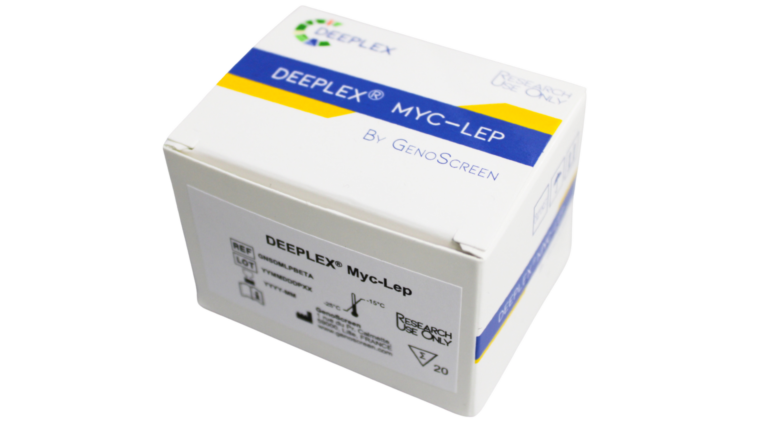Get a free tailored demonstration based on your needs.

The all-in-one solution for leprosy drug resistance detection and epidemiological control
Deeplex Myc-Lep, developed by GenoScreen, is an innovative culture-free solution for detection of leprosy drug resistance. Directly usable from skin biopsies and slit-skin smears, it uses a tailored multi-target sequencing technology to simultaneously predict (hetero-) resistance of Mycobacterium leprae to four used anti-leprosy drugs (rifampicin, dapsone, fluoroquinolone and bedaquilin) and to identify strain type for epidemiological surveillance.
Deeplex Myc-Lep represents a comprehensive solution to both guide rapid clinical-making decision for leprosy treatment and for molecular tracing of (drug resistant) leprosy strains.
4
anti-leprosy drugs
screened
31
targets for high-resolution strain typing
>100
mycobacterial species detectable
48h
from clinical samples to sequencing results
Deeplex Myc-Lep
includes
- Single 44-plex PCR mix: simultaneous amplification of leprae-specific DNA targets comprising all known drug resistance-associated genes, 29 core markers for high-resolution strain genotyping as well as a gene target for mycobacterial identification.
- Internal and positive controls for in-sample quality and test validation.
- Automated analysis via GenoScreen proprietary secure pipeline.
- User–friendly report for comprehensive visualisation of results.
Download the technical note
Don't forget leprosy (or Hansen's disease)
Leprosy, also called Hansen’s disease, is a chronic infectious disease caused by Mycobacterium leprae and more rarely, by M. lepromatosis. It predominantly affects the skin and peripheral nerves. Left untreated, the disease may cause progressive and permanent disabilities. Unlike commonly thought, leprosy is still present, with a significant impact in various regions of the world, including South-East Asia, Africa and South America.
Today, 3 to 4 million people are living with visible impairments or deformities due to leprosy and 200 000 new cases are reported each year worldwide.
About 30 million people are considered to be at risk and need to be treated with chemoprophylaxis to reach the WHO target of a 70% reduction in incidence by 2030.
Although substantial progress has been achieved over the past decades thanks to multi-therapy, there is still a long way to go to eradicate the disease.
Improve diagnosis, end transmission
Passive case detection of M. leprae and multidrug therapy have proved to be insufficient to interrupt leprosy transmission. (Multi-)Drug-resistant strains are being increasingly found, posing a serious threat to the efficacy of current treatments and impeding efforts to eliminate the disease.
Therefore, expanded antimicrobial resistance monitoring and improved epidemiological surveillance represent major pillars of the WHO’s 2021-2030 strategy “Towards zero leprosy”. The Deeplex Myc-Lep assay is unique in that both components can be addressed in one single PCR assay, followed by sequencing.
The test is applied on DNA extracted from clinical specimens, thereby overcoming the major biological and technical challenge represented by the inability to grow M. leprae on artificial media for performing conventional drug susceptibility testing and strain typing.

Our references
2023
Hi-plex deep amplicon sequencing for identification, high-resolution genotyping and multidrug resistance prediction of Mycobacterium leprae directly
from patient biopsies by using Deeplex Myc-Lep
Jouet A. et al.
eBioMedicine
2022
Investigating drug resistance of Mycobacterium leprae in the Comoros: an observational deep-sequencing study
Sofie Marijke B. et al.
Lancet Microbe
